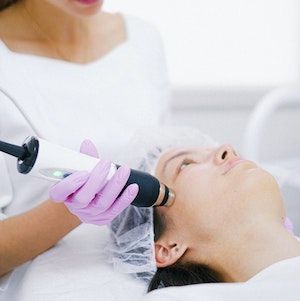News
Article
Laser Treatment Shown to Slightly Enhance Dermal Delivery of Minoxidil for Those with Androgenetic Alopecia
Author(s):
The results of this analysis indicated that while improvement was seen in both groups, slight dermoscopy score improvement was observed in those given a combination laser-minoxidil treatment compared to only minoxidil.

A combination of ablative fractional erbium YAG 2940-nm laser along with minoxidil slightly improves outcomes for those with androgenetic alopecia (AGA), according to new findings, indicating that lasers may be able to potentiate minoxidil’s effects.1
Prior research looking at both humans and animals have resulted in findings indicating ablative and non-ablative lasers have had positive effects on hair growth as well as improvement in alopecia.2
This latest research was authored by Zahra Zavare, MD, from the Skin Diseases and Leishmaniasis Research Center’s Department of Dermatology at Isfahan University of Medical Science in Isfahan, Iran.
“Various studies have shown the effectiveness of different laser types in the treatment of AGA, especially when combined with other treatments,” Zavare and colleagues wrote. “This study was designed to evaluate the efficacy of combined fractional ablative erbium YAG laser with topical 5% minoxidil versus minoxidil alone in male patients with AGA.”
Background and Findings
The study’s investigators used a randomized, parallel-group trial design and conducted their research on 30 male participants with diagnoses of moderate-to-severe androgenetic alopecia. The study was carried out at medical centers associated with Isfahan University of Medical Sciences in the period between May of 2020 and May of 2022.
They determined eligible participants to be those with moderate-to-severe scalp involvement based upon the Norwood scale, aged over 20 years, and willing to take part in the research. The team made the exclusion criteria include other kinds of alopecia, existence of conditions such as psoriasis or lichen planus, systemic diseases considered to be serious, photosensitivity, and hair transplantation history.
The sample size of the team’s study was decided to be 15 participants per group. The investigators conducted randomization based upon the days in which participants were referred: those referred on some of these days were placed in the intervention arm receiving both minoxidil and erbium YAG laser treatment, and others were sent to the control arm receiving only minoxidil.
Those in the intervention arm were given topical 5% minoxidil solution twice per-day in addition to 6 sessions of 2940-nm ablative fractional erbium YAG laser treatment with intervals of 2 weeks. The control arm was treated with only topical 5% minoxidil solution twice daily. Both of the groups were treated for a total of 6 months.
The investigators assessed disease severity using the Hamilton–Norwood scale, demographic data, assessments of safety, and adverse effects at the time of each follow-up meeting. The outcomes of treatment were examined through the use of dermoscopy, photography, and satisfaction evaluations following 24 weeks.
The research team took photographs from various angles, and 2 blinded dermatologists were instructed to evaluate the participants with a 7-point scale. Dermoscopy was conducted on specific scalp regions, and results were graded similarly to the photos. Satisfaction of participants was given a score from a 7-point scale, with a range from major deterioration to major improvement.
The investigators ended up with 30 total individuals with a mean age of 33.7 ± 8 years and mean disease duration of 12.4 ± 8 years. The 2 arms of the study, treated with either laser-minoxidil treatment or minoxidil by itself, were well-matched according to their demographic and clinical qualities.
The research team found that both of these study arms were shown to have substantial improvement in the satisfaction scores, photo scores, and results of dermoscopy following treatment. Disease duration exhibited a negative correlation with treatment response, with better outcomes observed in patients with lower Hamilton–Norwood scale scores and shorter disease durations.
Dermoscopic evaluation highlighted a substantial distinction between the 2 groups, favoring the laser and minoxidil combination (P = 0.016), but no difference was shown in photography scores (P = 0.13) or in satisfaction rankings (P > 0.05). The adverse effects were comparable between both arms, with seborrheic dermatitis and scalp itch noted in the minoxidil-only arm and instances of hair shaft damage and dermatitis in the laser-minoxidil arm.
Overall, the investigators reached a conclusion that the combined laser-minoxidil group showed distinct dermoscopic improvements and the treatment was well-tolerated, with adverse effects having been distributed similarly between both arms of the study (P > 0.05).
“In terms of permanent adverse effects, the patients in neither group experienced any permanent or serious adverse effects, and all of the adverse effects, including itchiness, scaling, and erythema, were tolerable, which is consistent with the literature,” they wrote.
References
- Mokhtari, F, Zavare, Z, Iraji, F. Topical 5% minoxidil versus combined erbium YAG laser and topical 5% minoxidil in androgenetic alopecia: A randomized controlled trial. J Cosmet Dermatol. 2023; 00: 1-7. doi:10.1111/jocd.15955.
- Dabek RJ, Austen WG Jr, Bojovic B. Laser-assisted hair regrowth: fractional laser modalities for the treatment of androgenic alopecia. Plast Reconstr Surg Glob Open. 2019; 7(4):e2157.



